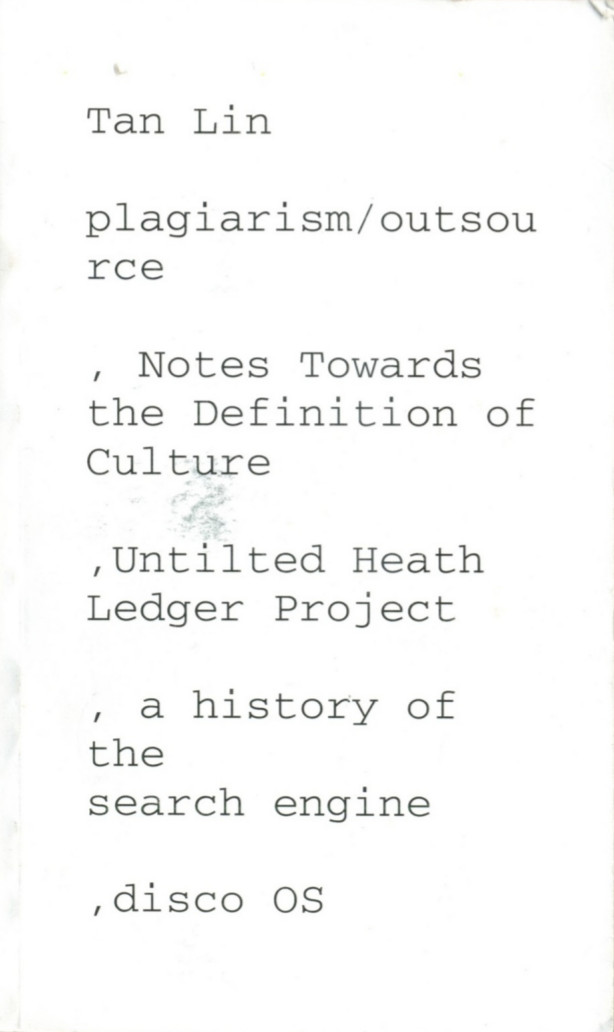Tan Lin: Heath: Plagiarism/Outsource (2009)
Filed under poetry | Tags: · ascii, blogging, facebook, fiction, plagiarism, poetry, search

“Poetry. Cross-genre. HEATH (PLAGIARISM/OUTSOURCE) exists somewhere between a Project Gutenberg version of Samul Pepys Diary and a minute-to-minute news feed and blog of Heath Ledger’s death. Sad, appropriated, lyrical and confused, the book contains a brief history of recent performance art, a legal defense of plagiarism, the diary of a poetry workshop at the Asian American Writer’s Workshop, an MP3 protest song, and an examination of SMS and GMS technologies as distribution networks for human sadness. Multi-authored, and with numerous text blocks and photos, HEATH (PLAGIARISM/OUTSOURCE), NOTES TOWARDS THE DEFINITION OF CULTURE, UNTITLED HEATH LEDGER PROJECT, A HISTORY OF THE SEARCH ENGINE, DISCO OS is in full color.”
Publisher Zasterle Press, La Laguna, 2009
ISBN 9788487467479
86 pages
Review: Kristen Gallagher (Criticism, 2009).
PDF, PDF (135 MB, no OCR, updated on 2017-4-20)
Annotated edition by Danny Snelson
Marie-Laure Ryan: Narrative as Virtual Reality: Immersion and Interactivity in Literature and Electronic Media (2001)
Filed under book | Tags: · computer games, fiction, hypertext, immersion, installation art, interactivity, literature, narrative, phenomenology, postmodern, reading, textuality, virtual reality

Is there a significant difference in attitude between immersion in a game and immersion in a movie or novel? What are the new possibilities for representation offered by the emerging technology of virtual reality? As Marie—Laure Ryan demonstrates in Narrative as Virtual Reality, the questions raised by new, interactive technologies have their precursors and echoes in pre—electronic literary and artistic traditions. Formerly a culture of immersive ideals — getting lost in a good book, for example — we are becoming, Ryan claims, a culture more concerned with interactivity. Approaching the idea of virtual reality as a metaphor for total art, Narrative as Virtual Reality applies the concepts of immersion and interactivity to develop a phenomenology of reading.
Ryan’s analysis encompasses both traditional literary narratives and the new textual genres made possible by the electronic revolution of the past few years, such as hypertext, interactive movies and drama, digital installation art, and computer role—playing games. Interspersed among the book’s chapters are several “interludes” that focus exclusively on either key literary texts that foreshadow what we now call “virtual reality,” including those of Baudelaire, Huysmans, Ignatius de Loyola, Calvino, and science—fiction author Neal Stephenson, or recent efforts to produce interactive art forms, like the hypertext “novel” Twelve Blue, by Michael Joyce, and I’m Your Man, an interactive movie. As Ryan considers the fate of traditional narrative patterns in digital culture, she revisits one of the central issues in modern literary theory — the opposition between a presumably passive reading that is taken over by the world a text represents and an active, deconstructive reading that imaginatively participates in the text’s creation.
Publisher Johns Hopkins University Press, 2001
ISBN 0801864879, 9780801864872
399 pages
PDF (updated on 2013-6-28, some images missing)
Comment (0)Jill Walker: Fiction and Interaction: How Clicking a Mouse Can Make You Part of a Fictional World (2003)
Filed under thesis | Tags: · fiction, gaming, hypertext, interactivity, literature
“This thesis is about works in which the user is a character in the fictional world, and it is about the kind of interaction that such works allow. In this introduction I will explain my research goals and introduce the theme of control, which is important in the thesis. I’ll also describe the genres I’m looking at, define some basic terms and present a summary of what each chapter deals with.”
Dr. art. thesis
Department of Humanistic Informatics, University of Bergen, 2003
Length 191 pages
More info (author)
More info (google books)

